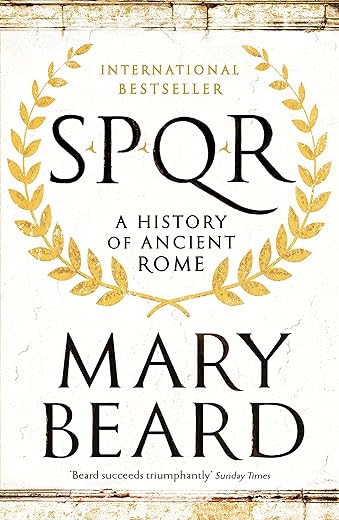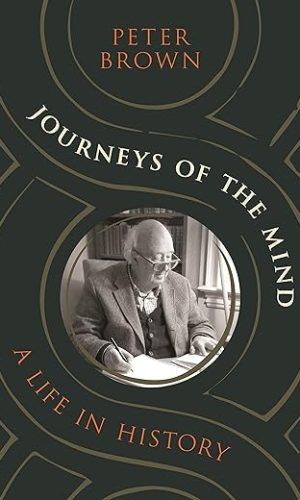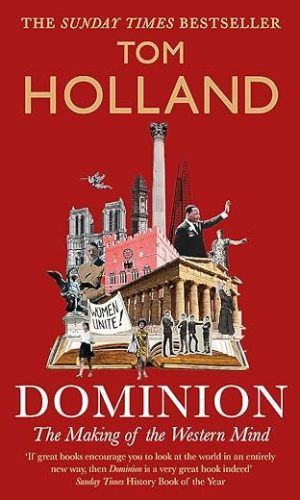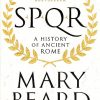SPQR: A History of Ancient Rome
£8.00£11.40 (-30%)
Mary Beard’s new book Emperor of Rome is available now
Ancient Rome matters.
Its history of empire, conquest, cruelty and excess is something against which we still judge ourselves. Its myths and stories – from Romulus and Remus to the Rape of Lucretia – still strike a chord with us. And its debates about citizenship, security and the rights of the individual still influence our own debates on civil liberty today.
SPQR is a new look at Roman history from one of the world’s foremost classicists. It explores not only how Rome grew from an insignificant village in central Italy to a power that controlled territory from Spain to Syria, but also how the Romans thought about themselves and their achievements, and why they are still important to us. Covering 1,000 years of history, and casting fresh light on the basics of Roman culture from slavery to running water, as well as exploring democracy, migration, religious controversy, social mobility and exploitation in the larger context of the empire, this is a definitive history of ancient Rome.
SPQR is the Romans’ own abbreviation for their state: Senatus Populusque Romanus, ‘the Senate and People of Rome’.
Read more
Additional information
| Publisher | Main edition (1 April 2016), Profile Books |
|---|---|
| Language | English |
| Paperback | 608 pages |
| ISBN-10 | 9781846683817 |
| ISBN-13 | 978-1846683817 |
| Dimensions | 12.8 x 3.8 x 19 cm |







by Sue
A really hard to read book
by Kindle Customer
Brilliant insights , gives you a real picture of how life in Rome ‘worked’ but never claims infallibility. Serious, humourous, an enthralling read
by Anselm
“History is just one damned thing after another”, goes a famous quote. And that’s what many introductory history books sound like: “First this happened, then that happened”. They might go as far as investigating causation (“this happened because that happened”) and even context (“this happened because of these circumstances”). But they don’t take the next step.
I’m currently reading in parallel Michael Burleigh’s book and Richard Evans’ trilogy on the Third Reich. They’re of this type. Now, that’s no criticism. For history that recent, the facts are going to be well-established enough not to warrant discussion in the main text, at least in a book intended for general rather than specialist readership. Sources can be relegated to footnotes for those keen and knowledgeable enough to follow them up. The facts material to, say, Hitler’s assumption of the German Chancellorship in January 1933 are not in dispute, and a lay reader like me is content to assume that the historian has done their homework with the sources, and to get on with following the narrative.
Ancient history is different. There are gaps. That’s also true of modern history, of course, but those in its ancient counterpart are so fundamental that a simple narrative history is actually misleading, because to say the equivalent of “Hitler assumed the Chancellorship on January 30th 1933” might very well not be true at all. How do we know he did? Because sources tell us. But what are those sources for ancient history?
When we’re told that in 509 BCE Lucius Junius Brutus forced Tarquinus Superbus, the last of the Roman kings, into exile in order to establish the liberty of the Roman people, that Tarquin made an alliance with the Etruscan king Lars Porsenna and besieged Rome in order to get his throne back, that the Etruscan army was prevented from crossing a key bridge across the Tiber by Horatius Cocles defending it single-handed, or almost single-handed, that the Etruscans abandoned the siege out of admiration for Roman spunk, and that Tarquinus’ Latin allies were finally defeated at the Battle of Lake Regillus in 499 BCE, it comes as something of a shock to then read in Beard’s “SPQR” that “it is only in the first century BCE that we can start to explore Rome, close up and in vivid detail, through contemporary eyes.” The earliest author to describe these foundational events is the historian Livy, writing in the time of Caesar Augustus, the first Roman emperor, half a millennium later. That raises the obvious question of how reliable this information about a series of events at least as significant for ancient Rome as Hitler’s accession to the Chancellorship was for Weimar Germany actually is.
This is the kind of question that’s at the heart of Beard’s book. On one level, it’s a history of ancient Rome from its foundation to 212 CE. As such, as pointed out by several previous reviewers (both positive and negative), it requires at least a basic knowledge of the subject. Noting these comments, I read all the Wikipedia articles on ancient Rome and its various aspects before embarking on this book. I was glad I did, although I’m not convinced I needed to. If, like one reviewer, I had complained about Beard’s skimpy treatment of, say, the Punic Wars, I would have missed what her book actually is.
As much as a history of Rome, it’s a history of the history of Rome. It asks the raft of questions that are an essential part of what we “know” (yes, that’s “know” in quotation marks) about it. How do we know what we think we know about a particular event or set of circumstances? What are the primary sources? How long after the event were they written? Why did the authors write what they did? For whom? Should we merely take their words at face value, or read them “against the grain”? What additional information can this reading between the lines reveal? How representative of his world and his time is a single main source for a whole period, like Cicero for the late Republic and the Civil Wars? How well does one source triangulate with othera(s)? What happens if they contradict one another? And how does all this tie in with archaeology?
This “history of history” is just as exciting a story as the one about “what actually happened”, and not just because the former is foundational to the latter. Even in contemporary history it enters the picture when, for example, David Irving’s misrepresentations of evidence are brought to light in his discussions of the Holocaust and the bombing of Dresden. We trust historians to do their work honestly, and nothing is as honest as actually showing the basis of your conclusions. It’s like a medieval timber-framed house in which the supporting structural members are a prominent feature of the design rather than being hidden behind an elegant facade. Beard does this par excellence in “SPQR”, elegantly combining the story with the story of the story in one engrossing narrative.
One model of history is the “Great Man” (yes, almost invariably “man”, unless we’re talking about great singers) view, in which the narrative consists of the doings of individual figures who are said to exercise a decisive influence on their societies. For ancient Rome, this would be the Mariuses and Sullas, the Pompeys and Caesars. From Augustus on, the history of Rome on this reading is of course the history of the emperors.
This is partly due to the simple fact that it tends to be the rich and powerful who leave the traces in the record. They build the buildings that survive, they command the armies that win (or lose) and that determine the fates of thousands and millions, it is their doings that are the subjects of sculpture and painting and monument and writing. The proles, meanwhile, pass unnoticed and unremarked unless they riot or rebel. Beard points out that the Roman Empire consisted primarily of some 50 million people, most of them peasant farmers who remain undifferentiated and anonymous because pretty much all evidence of them has vanished. Palaces can survive; peasant huts tend not to. But we do have some hope of reconstructing, to some degree, the lives, at least in the aggregate, of city dwellers, especially those million inhabitants of Rome who weren’t the few thousand elites. This is largely thanks to archaeology.
That’s why, if I had to choose my favourite chapter in the whole book, it would probably be Chapter 11, in which Beard determines just how much the evidence can tell us about the plebs. The answer is: more than you might think. Most Romans lived in “insulae”, multi-story apartment blocks, which is how a million could be crammed into such a relatively small footprint. Where and how they lived, what and where they ate and what they spent their little money on can all be determined, at least sufficiently for a mildly imaginative historical novelist to reconstruct an urban Roman scene and to get inside the heads of its ordinary citizens. Three conclusions would surprise us: Rome wasn’t zoned (the poor lived cheek by jowl with the rich throughout the city), the best apartments in insulae were on the lower, not the upper floors, and poor people ate out while rich ones dined at home.
Parallel to her examination of ordinary lives, Beard tries to determine what the impact on Rome was throughout the Empire. How much did Roman rule affect the inhabitants of Gaul or Egypt or Asia (i.e. modern western Turkey)? What did “being Roman” actually mean to a rural inhabitant of what is now Western Europe? How far down did “Romanisation” extend into the conquered societies?
And what did it mean to Romans themselves? This is a theme to which Beard periodically returns. We all have an image of our society, certain assumptions we tacitly make about our culture. It’s part of our mental makeup, the part that relates to our corporate rather than individual identities. What were Romans’ attitudes to Rome? These are intimately entwined (and perhaps enshrined?) in their city’s history, which was actually largely mythical – certainly the more so the further back it went. What they “knew” about Romulus and Remus and Aeneas reflected their own ambivalence, which was expressed in various ways throughout the near-millennium that it took for Rome to rise from an average Latin hilltop settlement whose wars were fought against enemies ten miles distant to superpower status.
Much of this evidence is, of course, skimpy in the extreme, far too much so to draw concrete conclusions. Beard again makes clear when this is so, and what such consensus or disagreement as there may be among historians and archaeologists on a given topic are. The only thing I wish she had specified is in her closing: in her discussion of the Arch of Constantine, I feel she could have made the difference between the figures on it that were recycled from earlier monuments and those freshly carved for it clear, in order to illustrate artistically her thesis about the new nature of the Empire after 212 CE.
The Kindle version works as well as you could expect. There’s X-ray, for what it’s worth, and the index is active as well as the table of contents. A minor exception is the (very useful) timeline at the end, which comes across as some kind of PDF. The fairly small font can’t be enlarged, and its various sections are of slightly different sizes, so you have to squint a bit. But it’s worth it – as is the entire book. If you want to know what happened in ancient Rome, read an introductory work. If you want to understand ancient Rome and how we’ve come to know about it, this is the book for you.
by M. C. Whiting
Mary Beard is up there in terms of current day classicists and her expertise on Ancient Rome makes her the perfect candidate to take on the role of producing a history of Rome for our time.
There is no doubt reading this that Beard really does live and breathe her subject matter and speaks to you as though she was there having conversations with these people. The book is often anecdotal, relatable and humorous. Making history relevant always has been Beard’s underlying quest to determine why history is still so important and how we can relate the past to the present and this book is no exception.
So why 3 stars? The stars awarded are a credit to Beard’s breadth of knowledge. Those parts of the book where you are gripped and the pleasure of being party to her enormous wealth of knowledge on a subject I love.
However, if I were to review this book on the basis of whether it sets out its objectives and satisfies the reader I’m not so sure. One thing that jumps out at you reading this book is that whether or not it is excellently researched or entertaining, it is NOT “a history of Ancient Rome” in terms of what many readers would expect.
For anyone who has a mild interest in Rome or has very little experience with it I would steer well clear of this book. Whilst Mary’s writing style is accessible, much of the content of this book is not for those who don’t have a working knowledge of Ancient Rome beforehand. Several names are peppered throughout sometimes expecting you to know who they are, events happening are taken for granted and more importantly so much is missing. In fact the book seems very deliberate in teaching you considerable amounts about the people and places you don’t normally hear about and glazing over the famous bits. Not only this but her consistent lack of committing to an answer (the ultimate “we just don’t know” attitude to ancient history) is far too frequent for me and begs the reader to infer why they are even reading this if the author isn’t invested in any of the sources she is working with.
If you write a history of Rome you either have a very long book (certainly longer than 537 pages) with considerable detail or you have a smaller book which covers the history briefly but without the detail.
Beard appears to do neither. Based on the length of this book it would be long enough to cover the first millennium of the Roman Empire (as it does) in relatively broad strokes. However, Beard appears to go into specific events or themes in microscopic and anecdotal levels of detail whilst glazing over pretty significant people and events. She adopts the strategy of going into detail (good) but only picks certain bits.
Take the emperors for example. The chapter on Augustus is superb and arguably the highlight of the book for me. Yet the chapter before it barely gets under the surface of Caesar (probably assuming we’ve heard all this before) and the chapter after runs through the following emperors up to commodus (lots of emperors) so quickly and doesn’t even cover some of them barely at all. Just taking the first few, Caligula is given a lot of coverage but Claudius gets next to nothing. Almost nothing said of the Flavian dynasty, Trajan, Hadrian, Marcus Aurelius etc in fact I’m not even sure Antoninus Pius is mentioned once.
It’s almost as though Beard has an agenda with this book. Essentially this book is about Mary Beard using her accessible and anecdotal writing style to explain how the Roman people (not just the important ones either) evolved and changed over 1,000 years socially and politically in terms of how an empire should be run and how it’s citizens should behave. The emphasis is clearly on social and political change. It’s no mistake that almost the first 40% of the book is entirely a political and social commentary on the rise and fall of the republic.
There are so many points in this book where I think “what am I reading?” And “I can’t follow this at all”. It’s like listening to a teacher who cannot resist but go off at a tangent. There’s nothing wrong with a tangential and anecdotal style but when you’re selling it as a “history of Ancient Rome” it’s easy to feel short changed. It’s like going shopping to buy one item and coming out with 20 different items minus the one you went in for. A lot of the time reading this book you feel like you are not learning history but you are just getting Beard’s opinions, anecdotal jokes or showing off her Latin. In this sense it may be a socio-political commentary on the first millennium in Rome but “a history of Ancient Rome” it isn’t I’m afraid.
Still worth a read and very insightful for anyone with some existing knowledge (if you are starting out please buy something else for now). For anyone wanting to know more about Augustus’ influence the chapter on him is superb. The final chapter on life in the provinces is also fascinating as this is rarely debated in other similar books. The first half of the book is very dull though and feels like it takes a long time ambling its way through Beard’s quasi-fetish of Cicero which dominates so much of the first half of the book.
I think if Mary Beard had sub-titled this book with the idea that it was socio-political commentary on the first millennium in Rome centred around Roman citizenship then it would be a 5 star book. Sadly what we have is a book that is interesting and insightful and written with superb expertise but ultimately isn’t what it says it is on the cover which makes it, at times, come across as a rambling and anecdotal mess with little thread or coherent chronology of history being communicated.
by Len Rushton
I’m only part-way into the book, but I’m a great fan of Mary Beard’s work and I do like to wallow in the mire of that strange society.